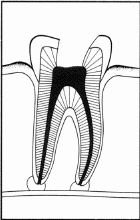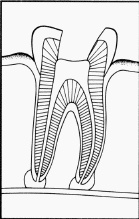|
A
root canal or endodontic
procedure on a tooth is simply the removal of the nerve of the tooth. This
is done in cases where the nerve is infected or traumatized.
Although many people
have heard horror stories about root canals, 99% of the time it is not a
painful procedure.
If the nerve becomes infected, (see toothaches) then
the nerve needs to be removed from the tooth. How do we do this? the tooth
is numbed using a local anesthetic. Once the tooth is numbed, an opening
is made into the nerve chamber using a dental hand piece. After the access
is gained, the contents of the nerve chamber are carefully removed using
special instruments. The chamber and the roots are them carefully cleaned
out using instruments and medications. After the canals are cleaned, they
are filled and sealed using a special material. This prevents any bacteria
from reinfecting the tooth. After a root canal is performed, it is
imperative to have a crown placed on the tooth. The crown protects the
tooth and prevents it from fracturing. After the crown is placed, the
tooth returns to normal function.
Figure 1 : Infected

As you can see from
figure 1, the tooth has become infected. This can be caused by a number of
factors including decay, trauma, or large failing restorations. The nerve
canal which appears black in the picture signifies the death of the pulpal
contents. Not only has the nerve died, but the blood vessels have also
died. The nerve chamber and its contents are removed by first gaining
access through the top of the tooth.
Figure 2 : Access opening and
cleaning of the canals

Once access is gained
to the nerve chamber, the contents are removed using special instruments
called "files". These are basically pipe cleaners that remove any debris
inside the chamber and canals. The number of canals varies from tooth to
tooth. Usually there is one canal per root. Anterior teeth have fewer
canals than posterior teeth. It is important that all the canals in a
tooth are thoroughly cleaned out. As you can see in figure 2, the file is
cleaning the canal to the end of the root.
Figure 3 : Canals cleaned and
ready to be filled

Once the canals have
been cleaned with the files, the canals are filled with a special filling
material. The purpose of this filling material is to seal the canals and
prevent future infections inside the tooth. After the canals have been
filled, the tooth is covered by a crown. This protects the now fragile
tooth from fracture. It is important that the crown be placed soon after
the root canal is finished otherwise once the tooth fractures, saving the
tooth becomes near impossible.
|
Here's how your tooth is saved through treatment:
|
- First, an opening is made through the crown of the
tooth.

An opening is made through the crown
of the tooth into the pulp chamber.
- The pulp is then removed. The root canal (s) is
cleaned and shaped to a form that can be filled.

The pulp is removed, and the root
canals are cleaned, enlarged and shaped.
- Medications may be put in the pulp chamber and root
canal (s) to help get rid of germs and prevent
infection.
- A temporary filling will be placed in the crown
opening to protect the tooth between dental visits.
Your dentist may leave the tooth open for a few days
to drain. You might also be given medicine to help
control infection that may have spread beyond the
tooth.

The pulp chamber and root
canals are filled and sealed.
- The temporary filling is removed and the pulp
chamber and root canal (s) are cleaned and filled.
- In the final step, a gold or porcelain crown is
usually placed over the tooth. If an endodontist
performs the treatment, he or she will recommend that
you return to your family dentist for this final step.

The crown of the tooth is then restored.
How long will the restored tooth last?
Your restored tooth could last a lifetime, if you
continue to care for your teeth and gums. However, regular
checkups are necessary. As long as the root (s) of a
treated tooth are nourished by the tissues around it, your
tooth will remain healthy.
|
![]()